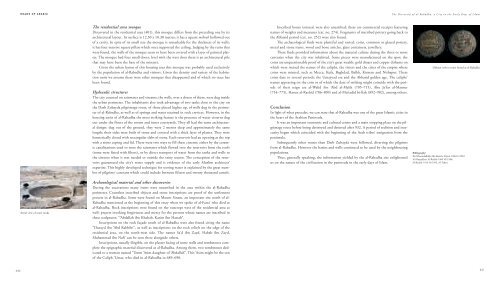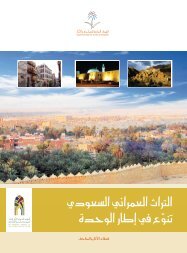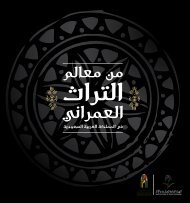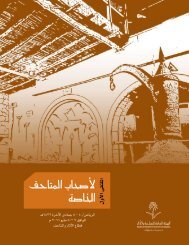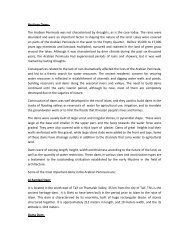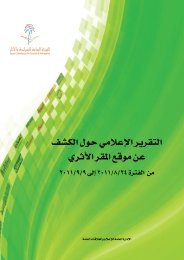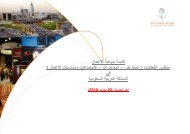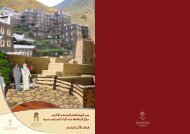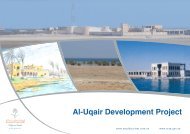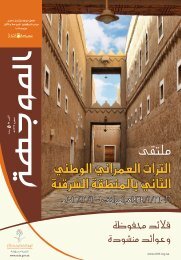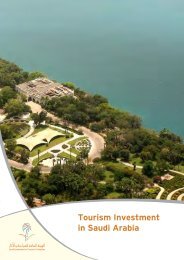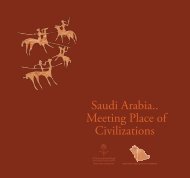Roads of Arabia
Roads of Arabia
Roads of Arabia
Create successful ePaper yourself
Turn your PDF publications into a flip-book with our unique Google optimized e-Paper software.
25 Arabie US p432-441_BAT.qxd 23/06/10 21:49 Page 440<br />
ROADS OF ARABIA<br />
The Discovery <strong>of</strong> al-Rabadha, a City in the Early Days <strong>of</strong> Islam<br />
The residential area mosque<br />
Discovered in the residential area (401), this mosque differs from the preceding one by its<br />
architectural layout. Its surface is 12.30 x 10.30 metres; it has a square mihrab hollowed out<br />
<strong>of</strong> a cavity. In spite <strong>of</strong> its small size the mosque is remarkable for the thickness <strong>of</strong> its walls:<br />
it has four massive square pillars which once supported the ceiling. Judging by the ruins that<br />
were found, the walls <strong>of</strong> the mosque seem to have been covered with a layer <strong>of</strong> painted plaster.<br />
The mosque had four small doors; level with the west door there is an architectural pile<br />
that may have been the base <strong>of</strong> the minaret.<br />
Given the urban layout <strong>of</strong> this housing area this mosque was probably used exclusively<br />
by the population <strong>of</strong> al-Rabadha and visitors. Given the density and variety <strong>of</strong> the habitation<br />
units we assume there were other mosques that disappeared and <strong>of</strong> which no trace has<br />
been found.<br />
Hydraulic structures<br />
The city counted on rainwater and streams; the wells, over a dozen <strong>of</strong> them, were dug inside<br />
the urban perimeter. The inhabitants also took advantage <strong>of</strong> two tanks close to the city on<br />
the Darb Zubayda pilgrimage route, <strong>of</strong> those placed higher up, <strong>of</strong> wells dug in the perimeter<br />
<strong>of</strong> al-Rabadha, as well as <strong>of</strong> springs and water retained in rock crevices. However, in the<br />
housing units <strong>of</strong> al-Rabadha the most striking feature is the presence <strong>of</strong> water cisterns dug<br />
out under the floors <strong>of</strong> the rooms and inner courtyards. They all had the same architectural<br />
design: dug out <strong>of</strong> the ground, they were 2 metres deep and approximately the same<br />
length; their sides were built <strong>of</strong> stone and covered with a thick layer <strong>of</strong> plaster. They were<br />
hermetically closed with rectangular slabs <strong>of</strong> stone. Each reservoir had an opening at the top<br />
with a stone coping and lid. There were two ways to fill these cisterns: either by the ceramic<br />
canalizations used to store the rainwater which flowed into the reservoirs from the ro<strong>of</strong>s<br />
(some were fitted with filters), or by direct transport <strong>of</strong> water from the tanks and wells to<br />
the cisterns when it was needed or outside the rainy season. The conception <strong>of</strong> the reservoirs<br />
guaranteed the city’s water supply and is evidence <strong>of</strong> the early Muslim architects’<br />
expertise. This highly developed technique for storing water is explained by the great number<br />
<strong>of</strong> pilgrims’ caravans which could include between fifteen and twenty thousand camels.<br />
Inscribed bones (ostraca) were also unearthed: these are commercial receipts featuring<br />
names <strong>of</strong> weights and measures (cat. no. 274). Fragments <strong>of</strong> inscribed pottery going back to<br />
the Abbasid period (cat. no. 252) were also found.<br />
The archaeological finds were plentiful and varied: coins, common or glazed pottery,<br />
metal and stone items, wood and bone articles, glass containers, jewellery.<br />
These finds provided information about the material culture during the three or more<br />
centuries when the city was inhabited. Some pieces were manufactured on the spot; the<br />
coins are unquestionable pro<strong>of</strong> <strong>of</strong> the city’s great wealth: gold dinars and copper dirhams on<br />
which were incised the names <strong>of</strong> the caliphs, the viziers and the cities <strong>of</strong> the empire where<br />
coins were minted, such as Mecca, Kufa, Baghdad, Balkh, Kirman and Nishapur. These<br />
coins date to several periods: the Umayyad era and the Abbasid golden age. The caliphs’<br />
names appearing on the coin or <strong>of</strong> which the date <strong>of</strong> striking might coincide with the periods<br />
<strong>of</strong> their reign are al-Walid ibn ‘Abd al-Malik (705–715), Abu Ja‘far al-Mansur<br />
(754–775), Harun al-Rashid (786–809) and al-Mu‘tadid bi-llah (892–902), among others.<br />
Conclusion<br />
In light <strong>of</strong> what precedes, we can state that al-Rabadha was one <strong>of</strong> the great Islamic cities in<br />
the heart <strong>of</strong> the <strong>Arabia</strong>n Peninsula.<br />
It was an important economic and cultural centre and a main stopping place on the pilgrimage<br />
route before being destroyed and deserted after 932. A period <strong>of</strong> sedition and insecurity<br />
began which coincided with the beginning <strong>of</strong> the Arab tribes’ emigration from the<br />
peninsula.<br />
Subsequently other routes than Darb Zubayda were followed, diverting the pilgrims<br />
from al-Rabadha. However the basins and wells continued to be used by the neighbouring<br />
populations.<br />
Thus, generally speaking, the information yielded by the al-Rabadha site enlightened<br />
us on the nature <strong>of</strong> the civilization in the peninsula in the early days <strong>of</strong> Islam.<br />
Dirham (silver coins) found at al-Rabadha<br />
Bibliography:<br />
Ibn Khurradadhbih; Ibn Rustah; Al-Jasir 1386 H./1967;<br />
Al-Muqaddasi; Al-Rashid 1406 H./1986;<br />
Al-Rashid 1414 H./1993; Al-Tabari.<br />
Aerial view <strong>of</strong> water tanks<br />
Archaeological material and other discoveries<br />
During the excavations many items were unearthed in the area within the al-Rabadha<br />
perimeter. Countless inscribed objects and stone inscriptions are pro<strong>of</strong> <strong>of</strong> the settlement<br />
process in al-Rabadha. Some were found on Mount Sinam, an important site north <strong>of</strong> al-<br />
Rabadha mentioned at the beginning <strong>of</strong> this essay when we spoke <strong>of</strong> al-Farra’ who died at<br />
al-Rabadha. Rock inscriptions were found on the outcrops west <strong>of</strong> the residential area as<br />
well: prayers invoking forgiveness and mercy for the persons whose names are inscribed in<br />
these sculptures: “‘Abdallah ibn Khabab, Karim ibn Hattab”.<br />
Inscriptions on the rock façade south <strong>of</strong> al-Rabadha were also found citing the name<br />
“Durayd ibn ‘Abd Rabbihi”, as well as inscriptions on the rock reliefs on the edge <strong>of</strong> the<br />
residential area, on the north-west side. The names Sa‘d ibn Zayd, Habab ibn Zayd,<br />
Muhammad ibn Nafi‘ can be seen there alongside others.<br />
Inscriptions, usually illegible, on the plaster facing <strong>of</strong> some walls and tombstones complete<br />
the epigraphic material discovered at al-Rabadha. Among them, two tombstones dedicated<br />
to a woman named “Umm ‘Asim daughter <strong>of</strong> ‘Abdallah”. This ‘Asim might be the son<br />
<strong>of</strong> the Caliph ‘Umar, who died in al-Rabadha in 689–690.<br />
440<br />
441


